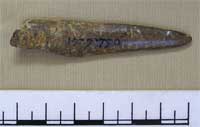| |
| |
| |
| |
| |
| |
THE WORK OF E.T. LEEDS:
SITE CASE STUDIES
Chastleton Iron Age Hill Fort
The Iron Age fort as Chastleton is situated on a mound known as Chastleton Burrow. The fort was situated in a good location to command views of the surrounding countryside. The site is a type known as a plateau fort and had a bank which enclosed about 1.4 hectares (3.5 acres).

View of Chastleton Burrow probably taken 1928-29.
The fort was first excavated in 1881 by members of the Society of Antiquaries who concluded the site was probably Roman. However in 1928-29 the Oxford University Archaeology Society with E.T. Leeds excavated several areas of the fort.
 |
 |
Stone lining at base of bank as excavated in 1928. |
Stone lined hearth excavated in 1929. |
The excavations revealed there had been a steep sided bank with stone blocks lining the base. No trace of any ditch could be found, which is unusual for hill-forts in this region. Hearths and post holes on the interior of the fort indicated it had been occupied at one time and these were presumed to be contemporary with the defences. E.T. Leeds concluded the site was an early and single period Iron Age hill-fort.
 |
|
Neolithic Bone Point (AN1929.790) |
No iron was found on the site and only one fragment of bronze. However iron age pottery was found together with a bone weaving comb, a bone needle, a fragment of neolithic bone, a stone spindle whorl and a piece of a shale bracelet. These finds are now held in the Ashmolean Museum.
REFERENCES:
E.T. Leeds (1931) 'Chastleton Camp, Oxfordshire, a hill-fort of the Early Iron Age', Antiquities Journal XI, p382-398.
J.E.G. Sutton (1966) 'Iron Age Hill-Forts and Some Other Earthworks in Oxfordshire', Oxoniensia XXXI, p35-36.